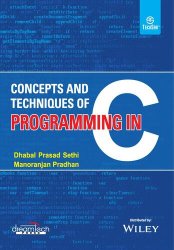 Название: Concepts and Techniques of Programming in C
Название: Concepts and Techniques of Programming in CАвтор: Dhabal Prasad Sethi, Manoranjan Pradhan
Издательство: I.K. International Pvt. Ltd./Dreamtech Press
Год: 2020
Страниц: 419
Язык: английский
Формат: pdf (true)
Размер: 10.1 MB
The C programming language is one of the most widely offered courses in the undergraduate programmes (all branches of BTech, BSc Computer Science, and BCA) as well as various postgraduate programmes (MCA, MSc Computer Science and others). Apart from students, the book will also be useful for aspirants of various competitive examinations and budding programmers. The book is straightforward and simple in its approach, deals with fundamentals of computer, algorithms and flowcharts, error handling, different data types, variables, operators, input/output operations, decision statements, looping, unconditional statements, functions, arrays, strings, pointers, dynamic memory management, structure and union, file and file handling, and preprocessor directives.
Chapter 1 deals with the fundamentals of computer which include the basic block diagram of a computer, RAM, ROM, input devices, output devices, number systems, problem solving, etc.
Chapter 2 discusses the algorithm and flowchart.
Chapter 3 presents C programming with introduction, general terminology, different types of error in C programming.
Chapter 4 deals with different types of data types, variables, rules of naming a variable, and different types of constant, token, keyword, identifier and others.
Chapter 5 focuses on different types of operator, e.g., arithmetic operator, logical operator, conditional, increment/decrement operator, relational, logical, bitwise operator and others.
Chapter 6 deals with input/output operations in C programming and includes introduction, reading a single character, writing a single character, escape sequences, delimiters, formatted input and output.
Chapter 7 discusses decision making statements, e.g., if statement, if else statement, nested if-else statement and switch statement.
Chapter 8 discusses and presents different types of looping in C programming, e.g., while loop, do while loop, for loops with their programming examples.
Chapter 9 presents unconditional statements, e.g., breaks, goto, continue and exit statements.
Chapter 10 focuses on the functions, i.e., library functions and user defined functions, different types of function, formal parameter, actual parameter, recursion, storage classes, etc.
Chapter 11 discusses arrays with program and theories of one-dimensional array, two-dimensional arrays and three-dimensional arrays.
Chapter 12 deals with string which hold different function getchar(), gets(), putchar(), puts(), strlen(), strcpy(), strcmp(), strcat(), strrev().
Chapter 13 deals with pointer, declaration, null pointer, generic pointer, pointer to pointer, pointer to array, array of pointer and dynamic memory management.
Chapter 14 discusses the structure, union, type definition, bit filed and others.
Chapter 15 discusses the file, text file vs binary files, file I/O function, file opening mode, error happed during I/O operation and others.
Chapter 16 deals with the preprocessor directives.
Скачать Concepts and Techniques of Programming in C